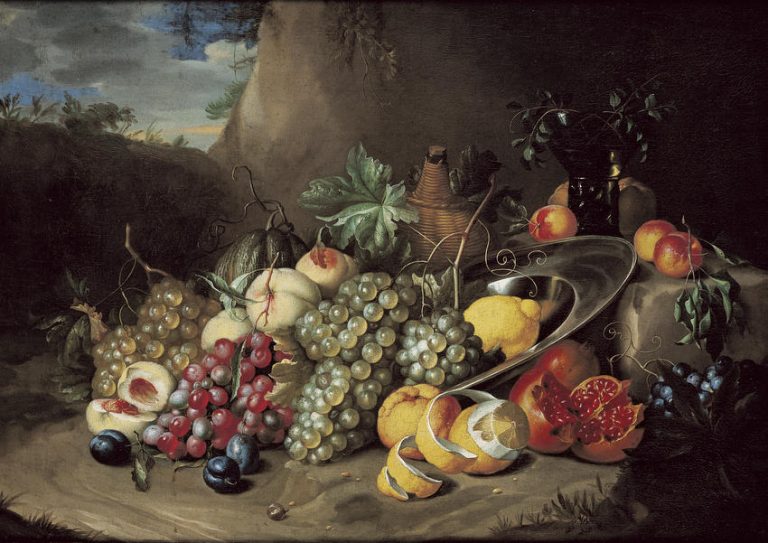We acknowledge the Traditional Owners of the land on which the Queensland Art Gallery | Gallery of Modern Art stands and recognise the creative contribution First Australians make to the art and culture of this country.

Alexander Coosemans / Flanders 1627–89 / Still life c.1650 / Oil on canvas / 58.2 x 83.5cm / Bequest of The Hon. Thomas Lodge Murray Prior, MLC, 1892 / Collection: Queensland Art Gallery | Gallery of Modern Art
Alexander CoosemansStill life c.1650
On Display: QAG, Gallery 9
In Still life c.1650, we see luscious peaches, pomegranates, plums, grapes and lemons spilling out from a bowl set within a dark landscape. Typical of the seventeenth-century Flemish tradition, a style which was extremely popular with middle- and upper-class patrons, this ripe arrangement conveys an image of prosperity, fertility and abundance.
The viewer is drawn to Coosemans’s work through the textures of the fruit, subtleties of light and colour, and the masterful rendering of detail. The pitted texture of the lemon rind with its peel suspended in an illusionistic envelope of space, the translucent, luminous hues of the grapes and the soft velvety sheen of the peaches combine to produce an overwhelming effect of naturalism.
The inclusion of the raffia bottle and the Italianate landscape in the background lends the work a slightly exotic atmosphere, reminding us that the growing interest in and depiction of exotic flora were the result of sea voyages and trade with the East and Mediterranean.
A painter of still lifes, Alexander Coosemans was born in Antwerp in 1627. In 1641, he was a pupil of Jan Davidsz de Heem (to whom this work was formerly attributed), a leading exponent of still-life painting in the seventeenth century.
In the Netherlands, painters and craftspeople were considered artisans and guilds were established to represent and protect their collective interests. A master and apprentice system encouraged the training of artisans by example and practice.
Coosemans was acknowledged by the Guild of St Luke as a master painter in 1645, at the age of only 18, due to the exceptionally high degree of finish in his work. The Guild of St Luke was a guild of painters and artisans based in Antwerp.
Discussion Questions
1. How has Coosemans made the fruit the focal point of his painting?
2. Exotic fruits were once used as symbols of colonial expansion. How do people currently document their travels to exotic or foreign places?
Classroom Activities
1. Arrange some fruit and vegetables to create a still-life tableau. Produce a composition using oil pastels. Discuss how to make the fruit and vegetables the central focus of the artwork. Look at the background in Coosemans’s artwork. Add a background that complements the arrangement.
2. Arrange your own still life by placing fruit in a bowl on a tabletop. Control the lighting of your arrangement by limiting the lighting in the room and experiment with the soft light of a lamp or a candle. Position the fruit within the composition to capture a sense of depth. As you draw, check your accuracy by noting the relationships and spacing between the fruit on the table with the fruit in your drawing.